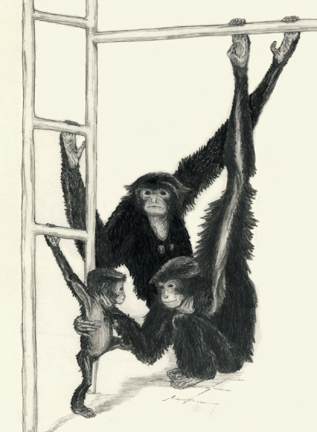
Shortly after Les was born, the Milwaukee siamangs became the subjects of a scientific study. Greysolynne Fox was a graduate student at a university in Milwaukee. She wanted to become a primate ethologist, a scientist who investigates and compares the behavior of different species of monkeys and apes.
The first discovery Greysolynne made was that the siamangs were extraordinarily interested in her. If she stood directly in front of the enclosure to get a good view of the animals, the siamangs immediately stopped whatever they were doing and came over to investigate her. They stood close to the glass and peered out intently. They put their hands on the window, apparently trying to touch her. Sometimes they licked the glass. Mark and Smitty performed for her, running off to brachiate around the cage and turn somersaults, then running back to the front of the enclosure to make sure she was watching. When Greysolynne placed her notebook on a ledge in front of the cage glass, the siamangs watched in fascination as she wrote. When she set a furry hat on the ledge, the siamangs tried to groom it through the glass.
The first time Greysolynne tried to tape record the siamangs’ calling sessions, she set up her machine next to the a shift cage, a small, barred cage connecting the two large enclosures. (A shift cage is used as a passageway when keepers want to move animals from one enclosure to another without handling them.) At once, Unk and Suzy came over to investigate, reaching out underneath the bars and trying to push the buttons on the tape recorder. Unk also revealed a fondness for rude pinching.

